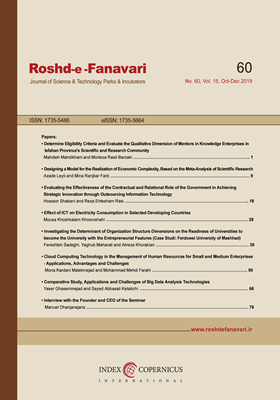-
-
List of Articles
-
Open Access Article
1 - Designing a Model for the Realization of Economic Complexity, Based on the Meta-Analysis of Scientific Research
azadeh leili Mina Ranjbarfard -
Open Access Article
2 - Investigating the Determinant of Organization Structure Dimensions on the Readiness of Universities to become the University with the Entrepreneurial Features (Case Studi: Ferdowsi University of Mashhad)
fereshte sadeghi yaghoob maharati alireza khorakian -
Open Access Article
3 - Evaluating the Effectiveness of the Contractual and Relational Role of the Government in Achieving Strategic Innovation through Outsourcing Information Technology
hossein shabani Reza Ehteshamrasi -
Open Access Article
4 - Effect of ICT on Electricity Consumption in Selected Developing Countries
mousa khoshkalam -
Open Access Article
5 - Determine Eligibility Criteria and Evaluate the Qualitative Dimension of Mentors in Knowledge Enterprises in Isfahan Province's Scientific and Research Community
Mahdieh mahdikhani Morteza rasti bozorki -
Open Access Article
6 - Cloud Computing Technology in the Management of Human Resources for Small and Medium Enterprises - Applications, Advantages and Challenges
Mona Kardani malekinezhad Mohammad Mahdi Farahi -
Open Access Article
7 - Comparative Study, Applications and Challenges of Big Data Analysis Technologies
Yaser Ghasemi nejad Abbass Ketabchi
-
The rights to this website are owned by the Raimag Press Management System.
Copyright © 2017-2026







